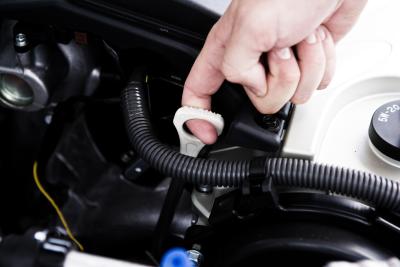
Removing your engine’s oil cap to find the underside clogged with crud is never a good sign, but it need not indicate a deformed head gasket and the top-end rebuild that necessitates. Even without constantly dropping coolant levels, any milky, mocha-colored creamy substance on the underside of the filler cap is the result of moisture becoming emulsified -- mixed in -- with the lubrication oil. Discovering and fixing the cause should be a priority.
A deformed head gasket typically allows coolant to escape into the engine, and the first symptom is a low coolant warning signal or abnormally high running temperatures. One of the head gasket’s main functions is to keep separate the tiny channels through which lubricating oil moves from those that channel coolant; if the gasket splits, the fluids mix. Check the dipstick for beads of moisture, and check the exhaust for pale gray or white “smoke,” even after the engine is fully warmed-up. If either is present, the cause for the moisture build-up inside the engine could be a deformed head gasket. Brown, white or green streaks on the lower portion of the dipstick also indicate a conspicuous coolant presence in the oil. A pressure test of the coolant system will reveal whether it is the case.
Conditions inside engines mimic those on the exterior. Condensation is a natural result of changes in ambient temperature, but condensation that escapes elsewhere is trapped inside engines. If a plunge in temperature has resulted in condensation forming, often as frost, on the outside of the car, a similar event could have occurred inside the engine. Warm, humid weather with a high dew point also can cause internal condensation, most commonly inside the crankcase.
These events typically do not cause white crud to build up in the engine because with normal vehicle use, the engine reaches temperatures that burn off the trapped moisture. In stored vehicles, however, and in those that are driven only short distances and never reach their optimum operating temperature, this sort of condensation can become an issue. Repeatedly driving short trips exacerbates the problem.
Upon discovering the crud under the filler cap, your initial fear may be that the entire inside of the engine is coated in it. That usually is not the case. Moisture collects in the coolest part of the engine, inside the valve covers and under the filler cap, so the place where it is noticed may be the only place it is present. Degreasing or washing mud off an engine with a pressure washer or the high-pressure jets at do-it-yourself, tunnel-style car washes, can force water into seals that only are designed to resist atmospheric pressure. Water can reach the inside of the engine through the dipstick port, or through the air cleaner entry point. A badly aimed jet can force water under the oil filler cap itself. Many engines are fitted with a scavenger hose that returns oil vapor from the cam covers to the engine block. If this hose becomes blocked, condensation can accumulate under the cam covers; again, this manifests as crud on the underside of the filler cap.
Diagnosing how the moisture came to be in what should be a hermetically-sealed area is key to resolving the cause; the white crud is merely a symptom. The diagnosis should be treated as a priority, because although the cost of replacing lost coolant probably is not significant, the side effects of its combustion may be expensive. When combusted, the ethylene-glycol combination in most antifreeze gives off byproducts that are derogatory to the exhaust system and to any pollution control devices located in the exhaust system. Further, corrosion from moisture can attack the surfaces of the cylinder barrels, the camshaft lobes, the tappet faces and small ground surfaces such as gear teeth. Corrosion increases oil consumption, leads to low compression readings and increases wear rate.